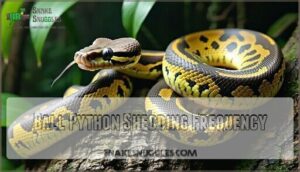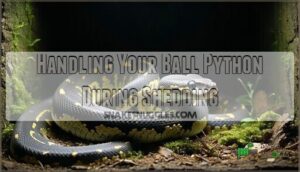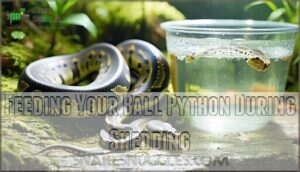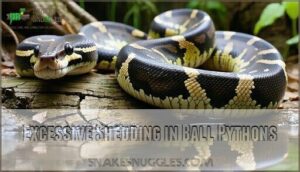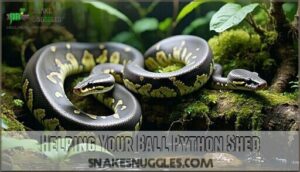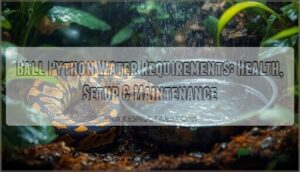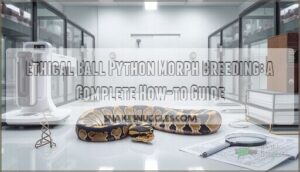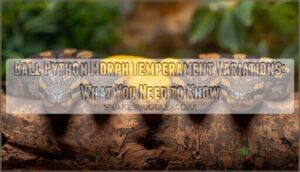This site is supported by our readers. We may earn a commission, at no cost to you, if you purchase through links.
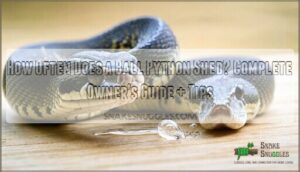
Younger snakes shed more frequently—sometimes every 3-4 weeks—while adults can stretch to 6-8 weeks between sheds.
Growth rate, humidity, and health all play their part in timing.
You’ll notice your snake’s eyes turn milky blue and their skin looks dull before they shed—that’s your cue to bump up humidity and give them space.
Think of shedding like changing clothes; it’s perfectly natural but requires the right conditions to go smoothly.
Understanding your snake’s unique rhythm helps you spot when something’s off.
Table Of Contents
- Key Takeaways
- How Often Does a Ball Python Shed?
- Ball Python Shedding Frequency
- Handling Your Ball Python During Shedding
- Feeding Your Ball Python During Shedding
- Excessive Shedding in Ball Pythons
- Incomplete Shedding in Ball Pythons
- Signs of Impending Shed in Ball Pythons
- Helping Your Ball Python Shed
- Frequently Asked Questions (FAQs)
- How often do ball pythons shed?
- How do ball pythons shed?
- Why is my ball python shedding too often?
- How do you know if a ball python is shedding?
- Do ball pythons eat their shed skin?
- How long does it take a ball python to shed skin?
- How long does it take for a ball python to shed?
- Can you leave a heat lamp on 24/7 for ball python?
- Can you hold a ball python while its shedding?
- How often should you pick up your ball python?
- Conclusion
Key Takeaways
- Your ball python will shed every 4-6 weeks on average, but younger snakes shed more frequently (every 3-4 weeks) while adults can go 6-8 weeks between sheds depending on their growth rate and health.
- You’ll know your snake’s about to shed when their eyes turn milky blue and their skin becomes dull – this is when you should increase humidity to 70-80% and avoid handling them completely.
- Don’t worry if your ball python refuses food during shedding – this appetite loss is completely normal and protects their health since cloudy eyes reduce their hunting ability.
- You can help your snake shed successfully by providing rough surfaces for rubbing, maintaining proper humidity, and offering lukewarm soaks if pieces of old skin get stuck after the shed.
How Often Does a Ball Python Shed?
When you’re wondering about your ball python’s shedding cycle, the answer depends on several key factors.
Young pythons shed every 3-4 weeks due to rapid growth, while adults typically shed every 4-6 weeks.
Growing pythons are like teenagers—constantly outgrowing their skin at lightning speed compared to their relaxed adult counterparts.
This ball python shedding frequency isn’t set in stone—Age vs. Shed patterns show juveniles outpace adults substantially.
Health and Shedding go hand-in-hand.
Well-nourished pythons maintain consistent snake shedding frequency, while stressed or sick animals may shed irregularly.
Diet and Shedding connect directly—faster-growing pythons fed regularly will shed more often than those on restricted diets.
Seasonal Shedding can slow during cooler months, and Genetics Influence Shed rates between individual snakes.
The complete ball python shedding process takes 7-14 days from initial signs to completion.
Understanding your python’s python shedding cycle helps you provide proper care during this vulnerable time.
Maintaining proper humidity helps guarantee healthy skin renewal.
Ball Python Shedding Frequency
Your ball python’s shedding frequency depends on several key factors that directly impact their growth and health.
Young pythons shed every 3-4 weeks during rapid development, while adults typically shed every 6-8 weeks.
Knowing when your snake will shed is important because environmental conditions matter for healthy shedding.
Here’s what influences ball python shedding frequency:
- Age and Growth Rate – Juvenile pythons shed more frequently to accommodate faster body development
- Diet and Health Impact – Well-fed, healthy snakes maintain consistent shedding patterns throughout their lives
- Seasonal Variation – Environmental changes can slightly alter your snake’s natural shedding schedule
Handling Your Ball Python During Shedding
Understanding shedding frequency helps you recognize the perfect time to minimize handling your ball python. When your snake enters the shedding cycle, hands-off becomes your golden rule.
The combination of reduced vision, heightened sensitivity, and stress makes even the gentlest snake unusually defensive and prone to aggression. Recognizing sensitivity during this vulnerable period prevents unnecessary complications.
Your python’s cloudy eyes and dull skin signal it’s time to avoid disturbing snake routines completely. Healthy ball pythons will typically undergo skin replacement regularly to accommodate growth.
| Shedding Stage | Handling Recommendation |
|---|---|
| Pre-shed (dull skin) | No handling |
| Blue phase (cloudy eyes) | Complete avoidance |
| Active shedding | Hands off entirely |
| Post-shed recovery | Wait 24-48 hours |
Safe interaction resumes only after complete skin removal. Gentle approaches and stress reduction through proper humidity make recovery smoother for everyone involved.
Feeding Your Ball Python During Shedding
Most ball pythons experience appetite loss during shedding, making feeding during shedding a common concern for owners.
Don’t panic when your ball python refuses dinner during shed week—it’s perfectly normal behavior that protects their health.
Food refusal happens because cloudy eyes reduce hunting ability and skin discomfort creates stress.
Here’s your feeding shedding ball pythons game plan:
- Skip feeding during active shedding phases to prevent digestion impact complications
- Maintain hydration importance with fresh water throughout the process
- Resume normal prey size offerings 1-2 days after shedding completes
- Stick to your feeding schedule once appetite returns post-shed
Don’t worry if your snake refuses meals – this feeding refusal behavior is completely normal and won’t harm healthy adults.
Shedding is a natural process akin to upgrading to a larger t-shirt.
Excessive Shedding in Ball Pythons
When your ball python starts shedding more frequently than normal, it’s signaling underlying health issues that need immediate attention. Excessive shedding disrupts your snake’s natural shedding cycle and creates unnecessary stress levels.
Shedding is a natural process, but is also influenced by temperature and humidity.
| Causes | Prevention |
|---|---|
| Parasite infestations (mites, ticks) | Regular health monitoring |
| Bacterial/fungal infections | Maintain proper humidity (50-60%) |
| Temperature fluctuations | Consistent temperature gradient |
| Poor habitat conditions | Clean substrate regularly |
| Nutritional deficiencies | Balanced feeding schedule |
Diagnosis requires careful observation of shedding frequency patterns. Treatment depends on identifying root causes, while veterinary care becomes essential when shedding problems python owners can’t resolve independently.
Incomplete Shedding in Ball Pythons
When your ball python’s shed comes off in pieces rather than one complete skin, you’re dealing with incomplete shedding.
This frustrating issue typically stems from humidity problems, inadequate nutrition, or stress affecting your snake’s natural process.
Here’s what incomplete shedding looks like:
- Patchy skin remnants clinging to your python’s body, especially around the tail and vent area
- Retained eyecaps appearing as cloudy films stuck over the eyes after shedding
Address stuck shed causes immediately by providing a moist hide and soaking your python in lukewarm water for 10-15 minutes.
Gently remove stubborn pieces with damp cotton swabs.
Maintaining proper humidity is key to avoiding dysecdysis complications.
Persistent shedding problems python owners face often require veterinary intervention to prevent infections or complications that could harm your snake’s health.
Signs of Impending Shed in Ball Pythons
Recognizing the early warning signs of ball python shedding helps you prepare your pet for this natural process. Your snake’s appearance will transform dramatically as shedding approaches.
The most noticeable change involves dull skin that loses its typical vibrant coloration, appearing gray or faded. You’ll also observe the distinctive blue eyes phase, where your python’s eyes become cloudy or bluish due to fluid buildup between skin layers.
Behavior changes accompany these physical transformations. Expect reduced activity as your snake becomes more lethargic and seeks hiding spots. A pink belly tint may develop, signaling the preshed stage is progressing.
During these python shedding signs, your ball python will likely refuse food and rub against objects more frequently. Understanding these shedding stages allows you to adjust humidity levels and minimize handling during this vulnerable blue phase period.
To guarantee a healthy shed, maintaining proper humidity levels is essential.
Sign Description
Helping Your Ball Python Shed
Now that you’ve spotted the python shedding signs, it’s time to create the perfect environment for your ball python shedding.
Humidity Importance can’t be overstated—maintain 70-80% during the shedding process by misting lightly or adding a humid hide with damp moss. Proper Hydration means providing fresh water constantly.
Your Enclosure Setup should include rough surfaces like branches for rubbing assistance. A temperature gradient is vital for healthy shedding.
When dealing with stuck skin or retained eye caps, Shedding Aids like lukewarm soaks work wonders. Soak your python for 10-15 minutes, then gently remove loose pieces with damp cotton swabs.
Handling Alternatives during shedding means minimal contact—let nature do its work while you provide ideal humidity for shedding.
Frequently Asked Questions (FAQs)
How often do ball pythons shed?
Don’t worry about your snake shedding too frequently – it’s actually normal! Your ball python will shed every 4-6 weeks as a juvenile, then every 6-8 weeks as an adult.
How do ball pythons shed?
Ball pythons shed by rubbing their nose against rough surfaces to create an opening, then crawling forward to peel off their entire skin like removing a sock inside-out.
Why is my ball python shedding too often?
Frequent shedding usually signals rapid weight gain, skin infections, or stress from poor husbandry.
Check your humidity levels, feeding schedule, and enclosure conditions—something’s likely triggering your python’s body to shed more than normal, which could be due to poor husbandry.
How do you know if a ball python is shedding?
Sarah noticed her snake’s skin looked unusually dull and cloudy one morning.
You’ll recognize shedding when your ball python’s skin becomes milky, eyes turn blue, and they become more reclusive and refuse food.
Do ball pythons eat their shed skin?
No, ball pythons don’t typically eat their shed skin like some other reptiles do.
They’ll usually leave it behind in their enclosure, so you’ll need to remove it during regular cleaning.
How long does it take a ball python to shed skin?
Complete shedding unfolds over seven to fourteen days, yet the actual skin removal happens quickly—you’ll watch your python slip free in just ten minutes to several hours once they start rubbing against surfaces.
How long does it take for a ball python to shed?
The entire shedding process takes 10-14 days from start to finish.
Your ball python’s skin will become dull, eyes turn milky blue, then clear before they actually shed in one piece.
Can you leave a heat lamp on 24/7 for ball python?
You shouldn’t leave a heat lamp on 24/7 for your ball python.
They need a natural day-night cycle with temperatures dropping at night.
Use a ceramic heat emitter for nighttime warmth instead.
Can you hold a ball python while its shedding?
Ironically, your snake craves solitude most when you want to help.
Don’t handle your ball python during shedding—it’s stressed, defensive, and fragile.
Wait until the process completes to avoid injuries, as this is when your snake is most fragile.
How often should you pick up your ball python?
You should handle your ball python once or twice weekly for 15-20 minutes maximum. Avoid handling during shedding periods, after feeding, or when they’re stressed to prevent defensive behavior.
Conclusion
Like maintaining a well-oiled machine, understanding how often a ball python sheds becomes second nature once you recognize the patterns.
Your snake’s individual rhythm typically falls within that 4-6 week window, but younger pythons shed more frequently while adults take longer between cycles.
Watch for milky eyes and dull skin as your cues to adjust humidity levels.
By staying attuned to these natural signals, you’ll guarantee smooth sheds and maintain your python’s prime health throughout their lifecycle.
- https://www.quora.com/What-happens-when-a-ball-python-sheds
- https://redinational.com/how-often-does-a-snake-shed-its-skin/
- https://talis-us.com/blogs/news/how-long-can-a-ball-python-go-without-eating?srsltid=AfmBOoqPux-Rk5A_5ju2P98mjfc1bVN3LjmiezDoGGq2qkH08sxXUdEZ
- https://digitalcommons.unl.edu/cgi/viewcontent.cgi?article=1268&context=envstudtheses
- https://www.wilbanksreptiles.com/blogs/ball-pythons/a-comprehensive-guide-to-pied-ball-python-for-beginners?srsltid=AfmBOoqlckle9OW1cZA3ZzqxbP7LS6u31zYjDRn1s4fQ9x8T9pIMFLhL

